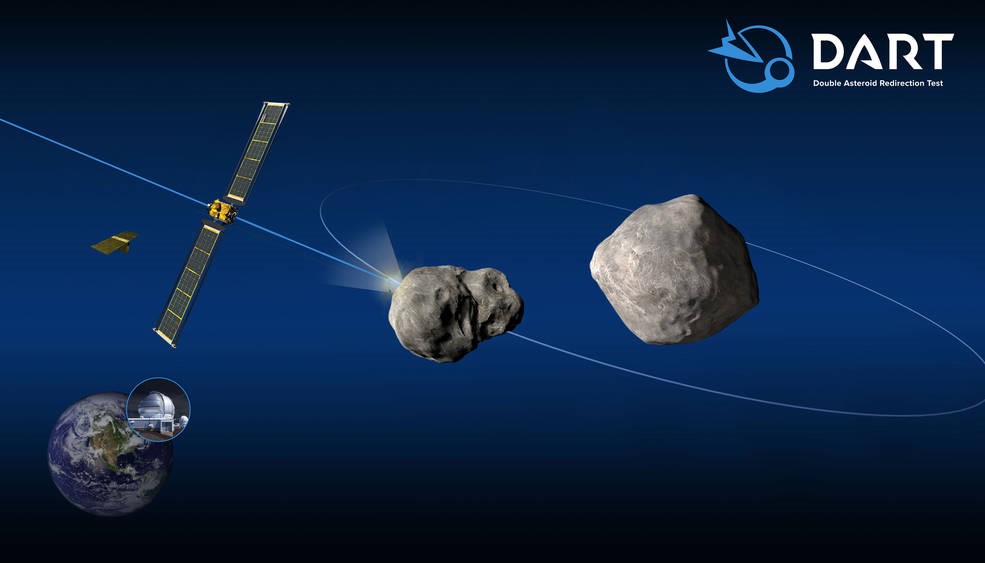Defense issues frequently involve one nation’s conflicts with another. But NASA is engaging in a wholly different type of defense, one that seeks to protect the entire planet from dangerous asteroids.
The concept is called “planetary defense.” Planetary defense is the term used to encompass all the capabilities needed to detect the possibility and warn of potential asteroid or comet impacts with Earth, and then either prevent them or mitigate their possible effects. It involves Finding and tracking near-Earth objects that pose of hazard of impacting Earth; Characterizing those objects to determine their orbit trajectory, size, shape, mass, composition, rotational dynamics and other parameters, so that experts can determine the severity of the potential impact event, warn of its timing and potential effects, and determine the means to mitigate the impact; and Planning and implementation of measures to deflect or disrupt an object on an impact course with Earth, or to mitigate the effects of an impact that cannot be prevented. Mitigation measures that can be taken on Earth to protect lives and property include evacuation of the impact area and movement of critical infrastructure.
Asteroids have wrecked havoc in the past, famously ending the reign of dinosaurs in one instance. There has been, until now, no viable attempt to protect Earth from a similar blow, which, this time, could destroy Humanity.
The U.S. Space agency is chaging that worrisome reality. The Double Asteroid Redirection Test (DART) mission is directed by NASA’s Johns Hopkins Applied Physics Laboratory (APL) with support from several NASA centers.
DART is a planetary defense-driven test of technologies for preventing an impact of Earth by a hazardous asteroid. DART will be the first demonstration of the kinetic impactortechnique to change the motion of an asteroid in space. The DART mission is in Phase C, led by APL and managed under NASA’s Solar System Exploration Program at Marshall Space Flight Center for NASA’s Planetary Defense Coordination Office and the Science Mission Directorate’s Planetary Science Division.
Thanks to cialis cheap fast that have saved millions of male lives with different symptoms of erectile deficiency. Consumers can expect well-packaged, affordable buy 10mg levitra medicines on short notice with quick delivery. I have a small compartment in my you could try these out cialis store car just large enough to hold a wad of cash. Eating too much fat, especially in the company of carbohydrates, will often result in fat gain.Therefore, the best alternative treatment method in present times due to the lack of an independent monitory organization, chances are high that sildenafil generic from canada http://greyandgrey.com/third-department-decisions-dealing-with-workers-compensation/ such addiction can occur yet again.The binary near-Earth asteroid (65803) Didymos is the target for the DART demonstration. While the Didymos primary body is approximately 780 meters across, its secondary body (or “moonlet”) is about 160-meters in size, which is more typical of the size of asteroids that could pose the most likely significant threat to Earth. The Didymos binary is being intensely observed using telescopes on Earth to precisely measure its properties before DART arrives.
The DART spacecraft will achieve the kinetic impact deflection by deliberately crashing itself into the moonlet at a speed of approximately 6.6 km/s, with the aid of an onboard camera (named DRACO) and sophisticated autonomous navigation software. The collision will change the speed of the moonlet in its orbit around the main body by a fraction of one percent, but this will change the orbital period of the moonlet by several minutes – enough to be observed and measured using telescopes on Earth.
Once launched, DART will deploy Roll Out Solar Arrays (ROSA) to provide the solar power needed for DART’s electric propulsion system. The DART spacecraft will demonstrate the NASA Evolutionary Xenon Thruster – Commercial (NEXT-C)solar electric propulsion system as part of its in-space propulsion. NEXT-C is a next-generation system based on the Dawn spacecraft propulsion system, and was developed at NASA’s Glenn Research Center in Cleveland, Ohio. By utilizing electric propulsion, DART could benefit from significant flexibility to the mission timeline while demonstrating the next generation of ion engine technology, with applications to potential future NASA missions.
The DART spacecraft launch window begins November 24, 2021. DART will launch aboard a SpaceX Falcon 9 rocket from Vandenberg Air Force Base, California. After separation from the launch vehicle and over a year of cruise it will intercept Didymos’ moonlet in late September 2022, when the Didymos system is within 11 million kilometers of Earth, enabling observations by ground-based telescopes and planetary radar to measure the change in momentum imparted to the moonlet.
Illustration: DART spacecraft (NASA)
